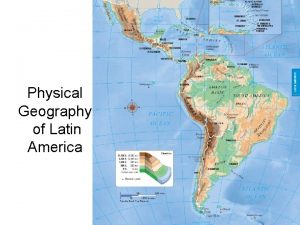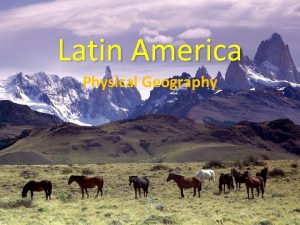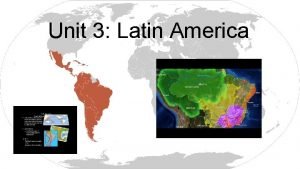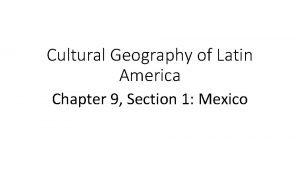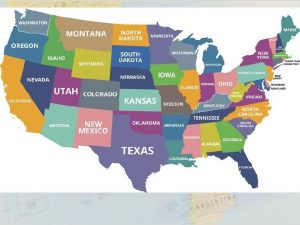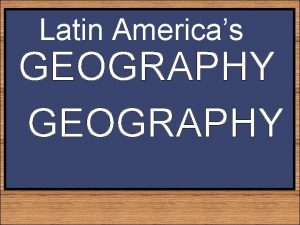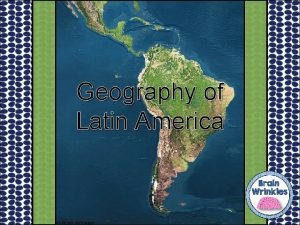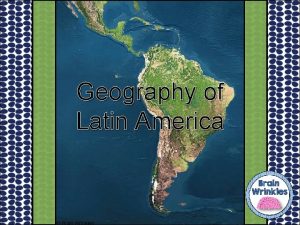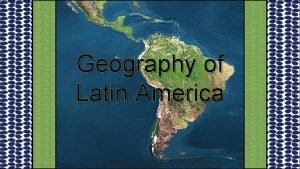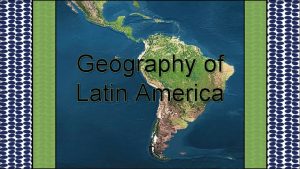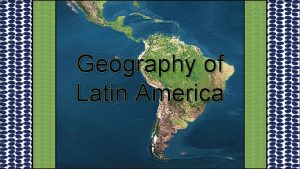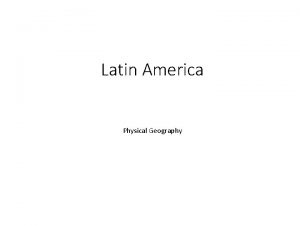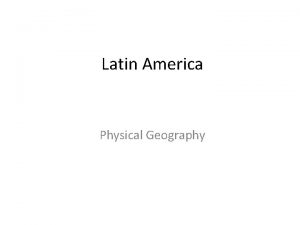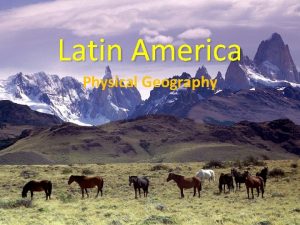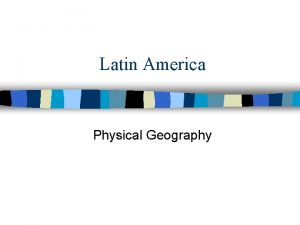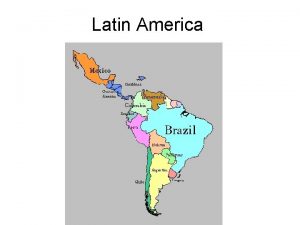Physical Geography of Latin America Latin America covers





















- Slides: 21

Physical Geography of Latin America

-Latin America covers 7, 000 miles -From the border of the U. S. and Mexico to Tierra del Fuego -Also includes the Caribbean Islands


-Andes Mountains: part of mountain chain that includes the Rocky Mountains and the Sierra Madres -Barrier for movement into the interior of South America -More settlement has occurred along eastern and northern coasts


-Llanos: grassy, treeless areas used for farming and livestock grazing found in Colombia and Venezuela -Cerrado: flat plains found in the interior of Brazil -Moderate rainfall makes it suitable for farming -Pampas: grasslands with rich soil located in Northern Argentina and Uruguay -Main products are cattle and wheat grain

River Systems -Orinoco River: flows more than 1, 500 miles, partly along the Colombia/Venezuela border -Amazon River: flows about 4, 000 miles from west to east, empties into Atlantic Ocean -Flows across Brazil -Has over 1, 000 tributaries


Natural Resources -Mineral resources: gold, silver, iron, and copper -Many minerals are mined in Latin America and shipped to other areas of the world for production

Natural Resources -Energy resources: oil, coal, natural gas, and hydroelectric power -Venezuela and Mexico have major oil reserves -Brazil is rich in hydroelectric power because of its many rivers -Caribbean Islands: main resource=tourism

Climate and Vegetation of Latin America

-Climate is extremely varied -Ranges from hot and humid conditions of the Amazon Rainforest to the dry desert regions of Northern Mexico

1. ) Tropical Climate Zones -rainforests: dense forests made up on different species of trees -Climate is hot and rainy yearround -Amazon rainforest covers more than 2, 000 square miles of South America -Contains many exotic plants and animals, such as jaguars and piranhas


2. ) Dry Climate Zones -Only found in Mexico and South America -semiarid: generally dry, with some rain -Grass-covered plains found in this region -Found in Mexico, Brazil, Uruguay, and Argentina

-desert: found in Northern Mexico as well as Chile (Atacama Desert) -Also in Southern Argentina (Patagonia) -Vegetation is mainly shrubs growing in gravel or sand




3. ) Mid-Latitude Climate Zones -mediterranean: hot, dry summers and cool, wet winters -Located along parts of the Western coast of Chile -similar to weather conditions in some parts of California

-marine west coast: cool, rainy winters and mild, rainy summers -Found in parts of Chile and Argentina Southern -Similar to weather conditions in Oregon and Washington in the U. S.
 Physical features of south america
Physical features of south america What is another arm of the atlantic ocean cradled by mexico
What is another arm of the atlantic ocean cradled by mexico Chapter 8: the physical geography of latin america answers
Chapter 8: the physical geography of latin america answers Latin america physical geography
Latin america physical geography Why is latin america called latin america
Why is latin america called latin america South america webquest
South america webquest Lesson 1 physical geography of south america
Lesson 1 physical geography of south america Geography of latin america color by number
Geography of latin america color by number Cultural geography of latin america
Cultural geography of latin america Traje tipico de soloma
Traje tipico de soloma Middle america physical map
Middle america physical map Political and physical features of latin america
Political and physical features of latin america Where is latin
Where is latin Physical features of south america
Physical features of south america Frq format ap human geography
Frq format ap human geography 5 themes of geography ap human geography
5 themes of geography ap human geography Stateless nation
Stateless nation South america facts geography
South america facts geography Rap of the states
Rap of the states America 2 europe
America 2 europe Repetition in let america be america again
Repetition in let america be america again Happening body art
Happening body art
